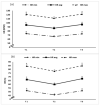Four Weeks of Detraining Induced by COVID-19 Reverse Cardiac Improvements from Eight Weeks of Fitness-Dance Training in Older Adults with Mild Cognitive Impairment
- PMID: 34073051
- PMCID: PMC8198940
- DOI: 10.3390/ijerph18115930
Four Weeks of Detraining Induced by COVID-19 Reverse Cardiac Improvements from Eight Weeks of Fitness-Dance Training in Older Adults with Mild Cognitive Impairment
Abstract
Physical training is considered as a low-cost intervention to generate cardioprotective benefits and to promote physical and mental health, while reducing the severity of acute respiratory infection symptoms in older adults. However, lockdown measures during COVID-19 have limited people's opportunity to exercise regularly. The aim of this study was to investigate the effect of eight weeks of Fitness and Dance training, followed by four weeks of COVID-19-induced detraining, on cardiac adaptations and physical performance indicators in older adults with mild cognitive impairment (MCI). Twelve older adults (6 males and 6 females) with MCI (age, 73 ± 4.4 y; body mass, 75.3 ± 6.4 kg; height, 172 ± 8 cm; MMSE score: 24-27) participated in eight weeks of a combined Fitness-Dance training intervention (two sessions/week) followed by four weeks of training cessation induced by COVID-19 lockdowns. Wireless Polar Team Pro and Polar heart rate sensors (H10) were used to monitor covered distance, speed, heart rate (HR min, avg and max), time in HR zone 1 to 5, strenuousness (load score), beat-to-beat interval (max RR and avg RR) and heart rate variability (HRV-RMSSD). One-way ANOVA was used to analyze the data of the three test sessions (T1: first training session, T2: last training session of the eight-week training program, and T3: first training session after the four-week training cessation). Statistical analysis showed that eight weeks of combined Fitness-Dance training induced beneficial cardiac adaptations by decreasing HR (HR min, HR avg and HR max) with p < 0.001, ES = 0.5-0.6 and Δ = -7 to-9 bpm, and increasing HRV related responses (max and avg RR and RMSSD), with p < 0.01 and ES = 0.4. Consequently, participants spent more time in comfortable HR zones (e.g., p < 0.0005; ES = 0.7; Δ = 25% for HR zone 1) and showed reduced strenuousness (p = 0.02, Δ = -15% for load score), despite the higher covered total distance and average speed (p < 0.01; ES = 0.4). However, these changes were reversed after only four weeks of COVID-19 induced detraining, with values of all parameters returning to their baseline levels. In conclusion, eight weeks of combined Fitness-Dance training seems to be an efficient strategy to promote cardioprotective benefits in older adults with MCI. Importantly, to maintain these health benefits, training has to be continued and detraining periods should be reduced. During a pandemic, home-based exercise programs may provide an effective and efficient alternative of physical training.
Keywords: HRV; aerobic; aging; cardiovascular health; combined training; heart rate; pandemics; performance; physical activity; responsiveness; strength; training cessation.
Conflict of interest statement
The authors declare no conflict of interest.
Figures




Similar articles
-
Effects of a 4-Week Detraining Period After 12 Weeks of Combined Training Using Different Weekly Frequencies on Health-Related Physical Fitness in Older Adults.Int J Environ Res Public Health. 2024 Oct 29;21(11):1433. doi: 10.3390/ijerph21111433. Int J Environ Res Public Health. 2024. PMID: 39595700 Free PMC article. Clinical Trial.
-
Monitoring training load in youth soccer players: effects of a six-week preparatory training program and the association between external and internal loads.Biol Sport. 2023 Jan;40(1):63-75. doi: 10.5114/biolsport.2023.112094. Epub 2022 Jan 3. Biol Sport. 2023. PMID: 36636199 Free PMC article.
-
DiADEM-Dance against Dementia-Effect of a Six-Month Dance Intervention on Physical Fitness in Older Adults with Mild Cognitive Impairment: A Randomized, Controlled Trial.J Pers Med. 2024 Aug 22;14(8):888. doi: 10.3390/jpm14080888. J Pers Med. 2024. PMID: 39202080 Free PMC article.
-
Dancing for Healthy Aging: Functional and Metabolic Perspectives.Altern Ther Health Med. 2019 Jan;25(1):44-63. Altern Ther Health Med. 2019. PMID: 29428927 Review.
-
Effects of dancing on physical activity levels of children and adolescents: a systematic review.Complement Ther Med. 2021 Jan;56:102586. doi: 10.1016/j.ctim.2020.102586. Epub 2020 Oct 9. Complement Ther Med. 2021. PMID: 33197661
Cited by
-
Impact of cardiorespiratory rehabilitation program on submaximal exercise capacity of Tunisian male patients with post-COVID19: A pilot study.Front Physiol. 2022 Sep 28;13:1029766. doi: 10.3389/fphys.2022.1029766. eCollection 2022. Front Physiol. 2022. PMID: 36246110 Free PMC article.
-
The Impact of Exercise Training Intensity on Physiological Adaptations and Insulin Resistance in Women with Abdominal Obesity.Healthcare (Basel). 2022 Dec 14;10(12):2533. doi: 10.3390/healthcare10122533. Healthcare (Basel). 2022. PMID: 36554057 Free PMC article.
-
Impact of Dog's Age and Breed on Dog Owner's Physical Activity: A German Longitudinal Study.Animals (Basel). 2022 May 20;12(10):1314. doi: 10.3390/ani12101314. Animals (Basel). 2022. PMID: 35625158 Free PMC article.
-
Effects of Different Exercise Interventions on Cardiac Autonomic Control and Secondary Health Factors in Middle-Aged Adults: A Systematic Review.J Cardiovasc Dev Dis. 2021 Aug 5;8(8):94. doi: 10.3390/jcdd8080094. J Cardiovasc Dev Dis. 2021. PMID: 34436236 Free PMC article. Review.
-
Unveiling the acute neurophysiological responses to strength training: An exploratory study on novices performing weightlifting bouts with different motor learning models.Biol Sport. 2024 Mar;41(2):249-274. doi: 10.5114/biolsport.2024.133481. Epub 2023 Dec 18. Biol Sport. 2024. PMID: 38524821 Free PMC article.
References
-
- Eurostat Population Structure and Ageing. [(accessed on 4 November 2019)]; Available online: https://ec.europa.eu/eurostat/statistics-explained/index.php?title=Popul....
-
- Population Ageing in Europe: Facts, Implications and Policies Outcomes of EU Funded Research. European Commission; Brussels: 2014. - DOI
-
- Vos T., Flaxman A.D., Naghavi M., Lozano R., Michaud C., Ezzati M., Shibuya K., A Salomon J., Abdalla S., Aboyans V., et al. Years lived with disability (YLDs) for 1160 sequelae of 289 diseases and injuries 1990–2010: A systematic analysis for the Global Burden of Disease Study 2010. Lancet. 2012;380:2163–2196. doi: 10.1016/S0140-6736(12)61729-2. - DOI - PMC - PubMed
Publication types
MeSH terms
LinkOut - more resources
Full Text Sources
Medical
Miscellaneous

